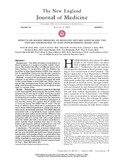Effects on blood pressure of reduced dietary sodium and the Dietary Approaches to Stop Hypertension (DASH) diet

View/
Date
2001Author
Miller, ER
Simons-Morton, DG
Karanja, N
Type
ArticleLanguage
enMetadata
Show full item recordAbstract
Hypertension affects almost 50 million people in the United States and places them at higher risk for cardiovascular diseases.1,2 Furthermore, this risk increases with progressive elevations in blood pressure, beginning at even normal levels of blood pressure.3 The Dietary Approaches to Stop Hypertension (DASH) trial demonstrated that a diet that emphasizes fruits, vegetables, and low-fat dairy products, that includes whole grains, poultry, fish, and nuts, that contains only small amounts of red meat, sweets, and sugar-containing beverages, and that contains decreased amounts of total and saturated fat and cholesterol lowers blood pressure substantially both in people with hypertension and those without hypertension, as compared with a typical diet in the United States.4 The DASH diet is now recommended in national guidelines.1,5 Clinical trials have shown that reducing the sodium chloride content of typical diets in the United States or northern Europe lowers blood pressure,6-8 and guidelines recommend reducing the daily dietary sodium intake to 100 mmol (equivalent to 2.3 g of sodium or 5.8 g of sodium chloride) or less.1
We undertook this trial to address several questions relevant to the prevention and treatment of hypertension. Does reducing the level of sodium from the average intake in the United States (approximately 150 mmol per day, which is equivalent to 3.5 g of sodium, or 8.7 g of sodium chloride) to below the currently recommended upper limit of 100 mmol per day lower blood pressure more than reducing the sodium level only to the recommended limit? We hypothesized that it would, on the basis of both the blood-pressure levels in populations with an average consumption of less than 60 mmol of sodium per day9 and data from incompletely controlled10-14 or small-scale15 clinical trials. Does the DASH diet lower the blood pressure beyond the level achievable by simply reducing sodium intake? What is the combined effect of the DASH diet and reduced sodium intake? The extent to which the reduction of the sodium level, in the context of a typical United States diet and in combination with the DASH diet, lowers blood pressure in people without hypertension is a much-debated6-8 issue critical to the prevention of hypertension.
Citation
Sacks, Frank M., et al. "Effects on blood pressure of reduced dietary sodium and the Dietary Approaches to Stop Hypertension (DASH) diet." New England Journal of Medicine 344.1 (2001): 3-10.Publisher
University of Nairobi, college of agriculture and veterinary sciences,
